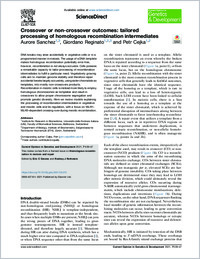Crossover or non-crossover outcomes : tailored processing of homologous recombination intermediates
- Sanchez, Aurore Institute for Research in Biomedicine (IRB), Faculty of Biomedical Sciences, Università della Svizzera italiana, Switzerland
- Reginato, Giordano Institute for Research in Biomedicine (IRB), Faculty of Biomedical Sciences, Università della Svizzera italiana, Switzerland - Department of Biology, Institute of Biochemistry, Eidgenössische Technische Hochschule (ETH), Zürich, Switzerland
- Cejka, Petr Institute for Research in Biomedicine (IRB), Faculty of Biomedical Sciences, Università della Svizzera italiana, Switzerland - Department of Biology, Institute of Biochemistry, Eidgenössische Technische Hochschule (ETH), Zürich, Switzerland
-
20.07.2021
Published in:
- Current opinion in genetics & development. - Elsevier. - 2021, vol. 71, p. 39-47
English
DNA breaks may arise accidentally in vegetative cells or in a programmed manner in meiosis. The usage of a DNA template makes homologous recombination potentially error-free, however, recombination is not always accurate. Cells possess a remarkable capacity to tailor processing of recombination intermediates to fulfill a particular need. Vegetatively growing cells aim to maintain genome stability and therefore repair accidental breaks largely accurately, using sister chromatids as templates, into mostly non-crossovers products. Recombination in meiotic cells is instead more likely to employ homologous chromosomes as templates and result in crossovers to allow proper chromosome segregation and promote genetic diversity. Here we review models explaining the processing of recombination intermediates in vegetative and meiotic cells and its regulation, with a focus on MLH1-MLH3-dependent crossing-over during meiotic recombination.
- Language
-
- English
- Classification
- Biotechnology
- License
- Open access status
- hybrid
- Identifiers
-
- RERO DOC 333687
- DOI 10.1016/j.gde.2021.06.012
- ARK ark:/12658/srd1319231
- Persistent URL
- https://n2t.net/ark:/12658/srd1319231
Statistics
Document views: 237
File downloads:
- Texte intégral: 371
